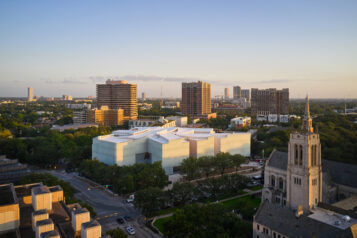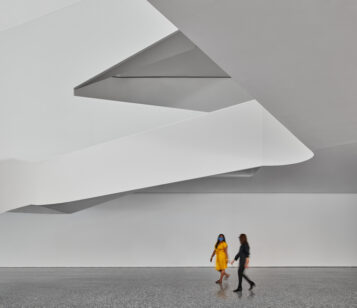
Construction is complete on the Museum of Fine Arts, Houston Nancy and Rich Kinder Building. This is the second phase of expansion for Texas’ oldest museum. McCarthy Building Companies, Inc. served as the construction manager at-risk for both phases, working with the design team, Steven Holl Architects, from the project’s inception to ensure the vision of the museum came to life. McCarthy utilized innovative technologies to construct models and plan for the unique challenges, features and materials that come with building a home for global art and culture.
The first phase of the MFAH project included a new 102,500-square-foot Glassell School of Art, nearly doubling the size of the previous building and creating space for the junior and adult schools, which serve 7,000 students each year. Phase two of the campus expansion project included the construction of the Nancy and Rich Kinder Building, a 183,500-square-foot exhibition building housing modern and contemporary art. The building features a translucent-glass exterior cool jacket, three floors of galleries that circle a three-story central atrium, a 225-seat theater, street-level café, restaurant overlooking the sculpture garden, an underground parking garage with 115 spaces and pedestrian tunnels connecting to the Glassell School of Art and the Caroline Weiss Law Building. The project broke ground in 2017.
The Nancy and Rich Kinder Building’s exterior façade was designed to be translucent and transparent, covered by approximately 1,100 semicircular glass tubes, 30 inches in diameter. The glass tubes are commonly referred to as the “cool jacket” attached to a concrete wall, supported by a catwalk system to allow maintenance and cleaning. Another feature includes the “billowing clouds of Texas” roof, with concave individual pieces forming scallops, and within the scallops are clerestory windows to provide natural light to the third-floor galleries and the atrium. The steel for the roof was custom-built, with no two beams the same, reflecting the different curves in the ceiling and roof.
McCarthy incorporated several technological advances into the project, including leveraging the design team’s 3D model of the geometric roof structure. The ceiling contractor manufactured the ceiling grid framing to build the organic finished ceiling shapes on level three that mimic the overall shape of the roof.






 Join our thriving community of 70,000+ superintendents and trade professionals on LinkedIn!
Join our thriving community of 70,000+ superintendents and trade professionals on LinkedIn! Search our job board for your next opportunity, or post an opening within your company.
Search our job board for your next opportunity, or post an opening within your company. Subscribe to our monthly
Construction Superintendent eNewsletter and stay current.
Subscribe to our monthly
Construction Superintendent eNewsletter and stay current.